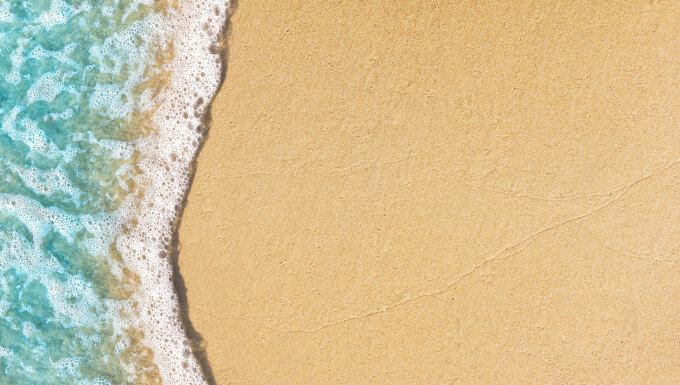Mineral light protection filters
Mineral and synthetic light protection filters work according to different operating principles. Synthetic sun protection filters combine with the sebum and convert sunlight into heat that is dissipated through the skin. It takes some time for the sun protection to develop completely. Minerals such as B. titanium dioxide and zinc oxide, however, lie on the skin and reflect the incident UV rays like a mirror the light. These natural light protection filters work immediately after application and are not hormone-active.
How does the mineral light protection work?
The mineral light protection filter developed by lavera is known in the specialist world as physical light protection. Our eyes perceive the minerals, i.e. the pigments in the emulsion, as a white sheen due to the light reflection on the skin, ie the skin appears whiter and less shiny than when using synthetic sunscreens.
More about UV radiation
The sun is good for you in moderation: its light is our most important source of the important vitamin D, its warmth makes most people feel good. In addition to all the positive effects, the sun also has its downsides: Most of the damage to our skin and a significant part of skin aging can be attributed to solar radiation - so-called UVA and UVB rays. It is therefore important to protect yourself adequately from it.
UVA rays
Long-wave UVA rays (320 to 400 nanometers) penetrate much deeper into the skin and can trigger structural changes in the skin's layers. The result is premature aging of the skin. In addition, UVA rays intensify the harmful effects of UVB rays and thereby increase the risk of sunburn and even skin cancer.
UVB rays
Short-wave UVB rays (290 to 320 nanometers) penetrate the top layer of skin, the epidermis, and damage the cells. They tan our skin and are also responsible for sunburn.
Mallorca acne
The so-called Mallorca or summer acne manifests itself as small but very itchy patches of skin, pimples or nodules that form mainly on the upper body. It mostly affects women between the ages of 20 and 40. The cause of Mallorca acne has not yet been researched, but the trigger is considered to be the interaction of UVA rays and the components of conventional, fatty sunscreens. People prone to Mallorca acne are advised to use mineral products such as lavera Sensitiv sun creams.
Sun allergy
Incidentally, Mallorca acne is often confused with a sun allergy: Here, however, it is not the wrong sun protection that is the trigger, but rather the renouncement of any sun protection products. The unprotected skin is overly sensitive. Why some people react in this way has not yet been clarified in this case either.
Skin types & dealing with the sun
Every skin has its own protection time. This is the period of time in which the skin outside does not suffer any damage, such as sunburn. The different skin types can be divided into 6 categories (see below).
With the following formula you can better estimate your individual sun protection time for responsible use of the sun:
Self-protection time x sun protection factor = possible stay in the sun
Example skin type 1: Approx. 10 min. X SPF 20 = 200 min. = 3 hours 20 min. Possible stay. The protection time of the skin is used up for the day. Therefore, do not stay in the sun too long despite using a sunscreen.
What skin type do I have?
Skin type 1
Has very fair skin with freckles, often blue eyes and reddish or light blonde hair. After about 5 to 10 minutes in the midday sun, this skin type already gets sunburn. It usually doesn't turn brown either.
Skin type 2
Has light skin and gray, green, or blue eyes and blonde or dark blonde hair. The skin will redden after approx. 10–20 minutes if it is not used to the sun. This type of skin turns tan slowly and the degree of tan is minimal.
Skin type 3
Progressively browns, usually has dark blonde or light brown hair and grEy or brown eyes. This skin type can be in the sun for around 20 to 30 minutes before sunburn occurs.
Skin type 4
With his brownish or olive-coloUred skin, he is largely spared from sunburn, usually has dark hair and brown eyes, and quickly becomes noticeably brown. The skin only turns red after more than 30 minutes when sunbathing.
Skin type 5
Has light brown or dark skin, brown eyes, and black hair, and tans quickly in the sun. Sunburn rarely occurs with this skin type, the self-protection is more than 90 minutes.
Skin type 6
This skin type has dark brown skin that quickly gains an additional tan when sunbathing. Sunburn practically never occurs. Here, too, the self-protection is more than 90 minutes and usually exceeds that of skin type 5.
What is the sun protection factor?
The sun protection factor (SPF) indicates how well a sunscreen protects against UVB radiation. Both the SPF as a numerical value and the associated protection class (e.g. "high" or "very high") can be found on a product. Even sunscreens with a very high sun protection factor do not offer absolute protection against UV radiation.




